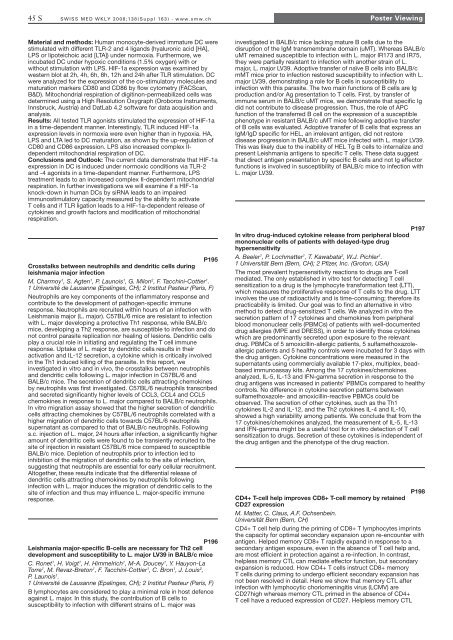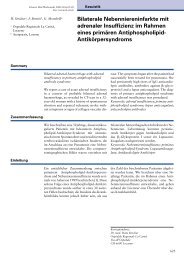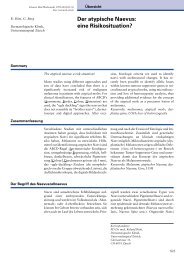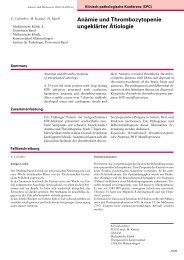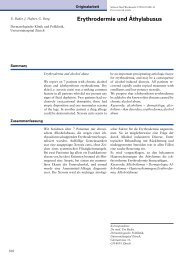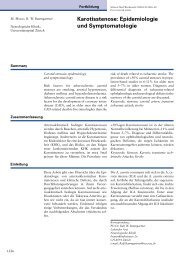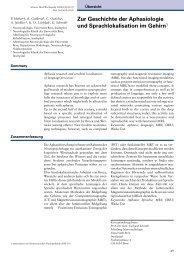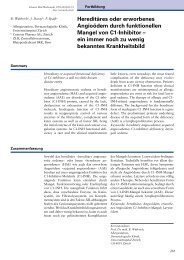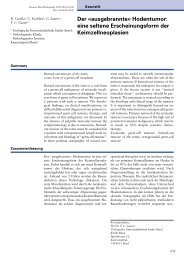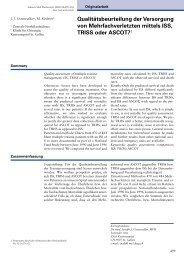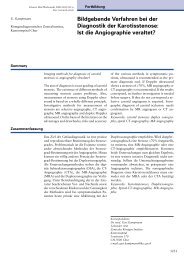Supplementum 163 - Swiss Medical Weekly
Supplementum 163 - Swiss Medical Weekly
Supplementum 163 - Swiss Medical Weekly
You also want an ePaper? Increase the reach of your titles
YUMPU automatically turns print PDFs into web optimized ePapers that Google loves.
45 S SWISS MED WKLY 2008;138(Suppl <strong>163</strong>) · www.smw.ch<br />
Poster Viewing<br />
Material and methods: Human monocyte-derived immature DC were<br />
stimulated with different TLR-2 and 4 ligands (hyaluronic acid [HA],<br />
LPS or lipoteichoic acid [LTA]) under normoxia. Furthermore, we<br />
incubated DC under hypoxic conditions (1.5% oxygen) with or<br />
without stimulation with LPS. HIF-1a expression was examined by<br />
western blot at 2h, 4h, 6h, 8h, 12h and 24h after TLR stimulation. DC<br />
were analyzed for the expression of the co-stimulatory molecules and<br />
maturation markers CD80 and CD86 by flow cytometry (FACScan,<br />
B&D). Mitochondrial respiration of digitinon-permeabilized cells was<br />
determined using a High Resolution Oxygraph (Oroboros Instruments,<br />
Innsbruck, Austria) and DatLab 4.2 software for data acquisition and<br />
analysis.<br />
Results: All tested TLR agonists stimulated the expression of HIF-1a<br />
in a time-dependent manner. Interestingly, TLR induced HIF-1a<br />
expression levels in normoxia were even higher than in hypoxia. HA,<br />
LPS and LTA led to DC maturation, as shown by the up-regulation of<br />
CD80 and CD86 expression. LPS also increased complex IIdependent<br />
mitochondrial respiration of DC.<br />
Conclusions and Outlook: The current data demonstrate that HIF-1a<br />
expression in DC is induced under normoxic conditions via TLR-2<br />
and -4 agonists in a time-dependent manner. Furthermore, LPS<br />
treatment leads to an increased complex II-dependent mitochondrial<br />
respiration. In further investigations we will examine if a HIF-1a<br />
knock-down in human DCs by siRNA leads to an impaired<br />
immunostimulatory capacity measured by the ability to activate<br />
T cells and if TLR ligation leads to a HIF-1a-dependent release of<br />
cytokines and growth factors and modification of mitochondrial<br />
respiration.<br />
P195<br />
Crosstalks between neutrophils and dendritic cells during<br />
leishmania major infection<br />
M. Charmoy1 , S. Agten1 , P. Launois1 , G. Milon2 , F. Tacchini-Cottier1 .<br />
1 Université de Lausanne (Epalinges, CH); 2 Institut Pasteur (Paris, F)<br />
Neutrophils are key components of the inflammatory response and<br />
contribute to the development of pathogen-specific immune<br />
response. Neutrophils are recruited within hours of an infection with<br />
Leishmania major (L. major). C57BL/6 mice are resistant to infection<br />
with L. major developing a protective Th1 response, while BALB/c<br />
mice, developing a Th2 response, are susceptible to infection and do<br />
not control parasite replication nor healing of lesions. Dendritic cells<br />
play a crucial role in initiating and regulating the T cell immune<br />
response. Uptake of L. major by dendritic cells results in their<br />
activation and IL-12 secretion, a cytokine which is critically involved<br />
in the Th1 induced killing of the parasite. In this report, we<br />
investigated in vitro and in vivo, the crosstalks between neutrophils<br />
and dendritic cells following L. major infection in C57BL/6 and<br />
BALB/c mice. The secretion of dendritic cells attracting chemokines<br />
by neutrophils was first investigated. C57BL/6 neutrophils transcribed<br />
and secreted significantly higher levels of CCL3, CCL4 and CCL5<br />
chemokines in response to L. major compared to BALB/c neutrophils.<br />
In vitro migration assay showed that the higher secretion of dendritic<br />
cells attracting chemokines by C57BL/6 neutrophils correlated with a<br />
higher migration of dendritic cells towards C57BL/6 neutrophils<br />
supernatant as compared to that of BALB/c neutrophils. Following<br />
s.c. injection of L. major, 24 hours after infection, a significantly higher<br />
amount of dendritic cells were found to be transiently recruited to the<br />
site of injection in resistant C57BL/6 mice compared to susceptible<br />
BALB/c mice. Depletion of neutrophils prior to infection led to<br />
inhibition of the migration of dendritic cells to the site of infection,<br />
suggesting that neutrophils are essential for early cellular recruitment.<br />
Altogether, these results indicate that the differential release of<br />
dendritic cells attracting chemokines by neutrophils following<br />
infection with L. major induces the migration of dendritic cells to the<br />
site of infection and thus may influence L. major-specific immune<br />
response.<br />
P196<br />
Leishmania major-specific B-cells are necessary for Th2 cell<br />
development and susceptibility to L. major LV39 in BALB/c mice<br />
C. Ronet 1 , H. Voigt 1 , H. Himmelrich 1 , M-A. Doucey 1 , Y. Hauyon-La<br />
Torre 1 , M. Revaz-Breton 1 , F. Tacchini-Cottier 1 , C. Bron 1 , J. Louis 2 ,<br />
P. Launois 1 .<br />
1 Université de Lausanne (Epalinges, CH); 2 Institut Pasteur (Paris, F)<br />
B lymphocytes are considered to play a minimal role in host defence<br />
against L. major. In this study, the contribution of B cells to<br />
susceptibility to infection with different strains of L. major was<br />
investigated in BALB/c mice lacking mature B cells due to the<br />
disruption of the IgM transmembrane domain (uMT). Whereas BALB/c<br />
uMT remained susceptible to infection with L. major IR173 and IR75,<br />
they were partially resistant to infection with another strain of L.<br />
major, L. major LV39. Adoptive transfer of naïve B cells into BALB/c<br />
mMT mice prior to infection restored susceptibility to infection with L.<br />
major LV39, demonstrating a role for B cells in susceptibility to<br />
infection with this parasite. The two main functions of B cells are Ig<br />
production and/or Ag presentation to T cells. First, by transfer of<br />
immune serum in BALB/c uMT mice, we demonstrate that specific Ig<br />
did not contribute to disease progression. Thus, the role of APC<br />
function of the transferred B cell on the expression of a susceptible<br />
phenotype in resistant BALB/c uMT mice following adoptive transfer<br />
of B cells was evaluated. Adoptive transfer of B cells that express an<br />
IgM/IgD specific for HEL, an irrelevant antigen, did not restore<br />
disease progression in BALB/c uMT mice infected with L. major LV39.<br />
This was likely due to the inability of HEL Tg B cells to internalize and<br />
present Leishmania antigens to specific T cells. These data suggest<br />
that direct antigen presentation by specific B cells and not Ig effector<br />
functions is involved in susceptibility of BALB/c mice to infection with<br />
L. major LV39.<br />
P197<br />
In vitro drug-induced cytokine release from peripheral blood<br />
mononuclear cells of patients with delayed-type drug<br />
hypersensitivity<br />
A. Beeler 1 , P. Lochmatter 1 , T. Kawabata 2 , W.J. Pichler 1 .<br />
1 Universität Bern (Bern, CH); 2 Pfizer, Inc. (Groton, USA)<br />
The most prevalent hypersensitivity reactions to drugs are T-cell<br />
mediated. The only established in vitro test for detecting T cell<br />
sensitization to a drug is the lymphocyte transformation test (LTT),<br />
which measures the proliferative response of T cells to the drug. LTT<br />
involves the use of radioactivity and is time-consuming; therefore its<br />
practicability is limited. Our goal was to find an alternative in vitro<br />
method to detect drug-sensitized T cells. We analyzed in vitro the<br />
secretion pattern of 17 cytokines and chemokines from peripheral<br />
blood mononuclear cells (PBMCs) of patients with well-documented<br />
drug allergies (MPE and DRESS), in order to identify those cytokines<br />
which are predominantly secreted upon exposure to the relevant<br />
drug. PBMCs of 5 amoxicillin-allergic patients, 5 sulfamethoxazoleallergic<br />
patients and 5 healthy controls were incubated for 3 days with<br />
the drug antigen. Cytokine concentrations were measured in the<br />
supernatants using commercially available 17-plex, multiplex, beadbased<br />
immunoassay kits. Among the 17 cytokines/chemokines<br />
analyzed, IL-5, IL-13 and IFN-gamma secretion in response to the<br />
drug antigens was increased in patients’ PBMCs compared to healthy<br />
controls. No difference in cytokine secretion patterns between<br />
sulfamethoxazole- and amoxicillin-reactive PBMCs could be<br />
observed. The secretion of other cytokines, such as the Th1<br />
cytokines IL-2 and IL-12, and the Th2 cytokines IL-4 and IL-10,<br />
showed a high variability among patients. We conclude that from the<br />
17 cytokines/chemokines analyzed, the measurement of IL-5, IL-13<br />
and IFN-gamma might be a useful tool for in vitro detection of T cell<br />
sensitization to drugs. Secretion of these cytokines is independent of<br />
the drug antigen and the phenotype of the drug reaction.<br />
P198<br />
CD4+ T-cell help improves CD8+ T-cell memory by retained<br />
CD27 expression<br />
M. Matter, C. Claus, A.F. Ochsenbein.<br />
Universität Bern (Bern, CH)<br />
CD4+ T cell help during the priming of CD8+ T lymphocytes imprints<br />
the capacity for optimal secondary expansion upon re-encounter with<br />
antigen. Helped memory CD8+ T rapidly expand in response to a<br />
secondary antigen exposure, even in the absence of T cell help and,<br />
are most efficient in protection against a re-infection. In contrast,<br />
helpless memory CTL can mediate effector function, but secondary<br />
expansion is reduced. How CD4+ T cells instruct CD8+ memory<br />
T cells during priming to undergo efficient secondary expansion has<br />
not been resolved in detail. Here we show that memory CTL after<br />
infection with lymphocytic choriomeningitis virus (LCMV) are<br />
CD27high whereas memory CTL primed in the absence of CD4+<br />
T cell have a reduced expression of CD27. Helpless memory CTL


